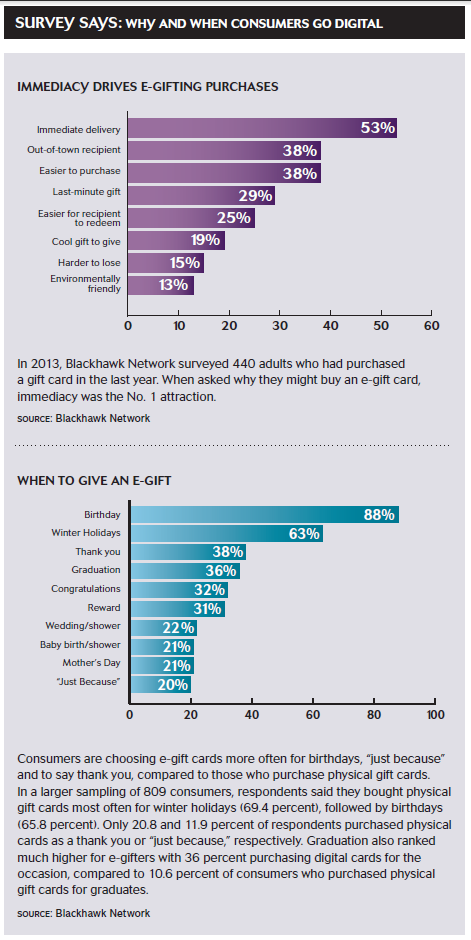Viewpoint: Gift Card Evolution, Not Revolution
Digital gift cards bring depth, not disruption, to gift card product lines.
 By Tammy Durston, Blackhawk Network
By Tammy Durston, Blackhawk Network
Despite what some have feared, digital gift cards aren’t disrupting the plastic gift card market by cannibalizing sales—they’re expanding opportunities. By appealing to a new group of buyers, more often males with higher incomes, who value convenience and last-minute shopping opportunities, digital gift cards are helping retailers sell more gift cards not fewer.
The digital gift card market is still quite small. Mercator Advisory Group estimates that in 2012 (the latest year for which data are available) only 3 percent of closed-loop gift card loads were on digital cards, which translates to approximately $2.9 billion—only a fraction of the $96.3 billion closed-loop gift card market in 2012. However, with U.S. adults now spending almost three-and-a-half hours on the Internet and almost two hours a day on their smartphones, it’s not surprising that gift card shopping also is migrating to the Web and mobile devices. This migration is slow-moving, and our research suggests there are several obstacles that need to be overcome to maximize consumer adoption of digital gift cards.
Some barriers will erode over time. Seven or eight years ago, many consumers felt plastic gift cards were too impersonal to make “good” gifts. As years passed, consumer sentiment regarding gift cards has changed dramatically as shoppers realized gift cards are a desired gift among many age groups, especially young people. Digital gift cards are moving along this same path. Purchases mostly are driven by immediacy of delivery, convenience and ease of purchase.
Who Are the Buyers?
While the occasions for e-gifts and physical gift cards varied, the givers/recipients of e-gifts were quite similar to physical gift card givers, with family and friends leading. In terms of demographics, digital gift card buyers (as compared to overall gift card buyers) tend to include a slightly higher percentage of males, age range 35 to 44, with higher incomes. This group also tends to buy fewer physical gift cards. The demographic group that tends to buy fewer in-store gift cards still wants to buy gift cards; they’re just choosing to buy them online/via mobile.
Millennials also are particularly fond of e-gift cards. In a separate study of 422 millennials in December 2013, almost half (49 percent) had received a digital gift card. One-third had received more than four e-gift cards in the last year. Most (88 percent) expect to receive an e-gift card in the next year. Millennials also tend to buy e-gift cards. Sixty-two percent planned to buy an e-gift card during the holiday season, with 56 percent planning on buying one to six e-gift cards. About one-half (51 percent) said they were interested in sending virtual gift cards through social media.
The Bottom Line
Digital gift cards bring several benefits to the entire gift card category. They extend the gift card selling cycle to all hours of the day and night, up to the day and time of the occasion when a gift is needed. Self-users also tend to buy digital gift cards. More than half (58 percent) of gift card buyers said they are likely to purchase a digital gift card for their own use (49 percent). What’s more, digital gift cards are gaining momentum as employee or partner incentives or customer rewards because they can be more cost-effective and convenient than physical cards.
Digital gift cards are growing but will not replace physical gift cards. There are distinct markets for each type of gift card and these segments can grow together if consumer objections are addressed (see sidebar). In particular, growth will continue if the consumer experience is optimized. Consumers must feel digital gift cards are easy to purchase and feel confident that recipients can redeem them easily.
Digital gift cards also must have personalization built in to the extent that recipients should feel like they are unwrapping a gift. Video, sound and photos can help buyers feel they’re giving a more tangible gift. Retailers should partner with digital providers that can address consumer concerns and help build a strong e-gift card sales channel.
Tammy Durston is senior director of research at Blackhawk Network, a Pleasanton, Calif.-based provider of prepaid and financial payments products. Her research helps guide Blackhawk’s strategy for its diverse product lines and geographies. She can be reached at [email protected].
In Viewpoints, prepaid and emerging payments professionals share their perspectives on the industry. Paybefore endeavors to present many points of view to offer readers new insights and information. The opinions expressed in Viewpoints are not necessarily those of Paybefore.
This Viewpoint appeared in the Spring 2014 edition of Pay Magazine.













































